The second day of a weekend of Summer birding, looking for some of our scarcer breeding birds, as well as the more regular species we can see here at this time of year. It was mostly cloudy but pleasantly warm and bright, and we managed for the most part to dodge the showers in the afternoon, at least until we had finished for the day.
On the drive down to the Brecks, we saw several Red Kites today, hanging in the air by the road. We took a meandering route, looking for Stone Curlews and other birds on the way down. The pig fields in the northern Brecks were full of Rooks, Jackdaws and gulls. We stopped to look through a particularly large flock of Lesser Black-backed Gulls and were rewarded with a single adult Yellow-legged Gull with them – larger, bulkier and with a much paler grey back and custard yellow legs.
The first couple of fields where we looked for Stone Curlew, we drew a blank. The vegetation is getting very tall now and the birds are getting much harder to see. But on our third stop, we found one Stone Curlew out in the open on rather bare and stony ground. Even though we remained at some considerable distance, it was a little nervous at first, running in a couple of short bursts across towards the edge of the field. We stood still behind the car and it quickly settled down, standing and preening.
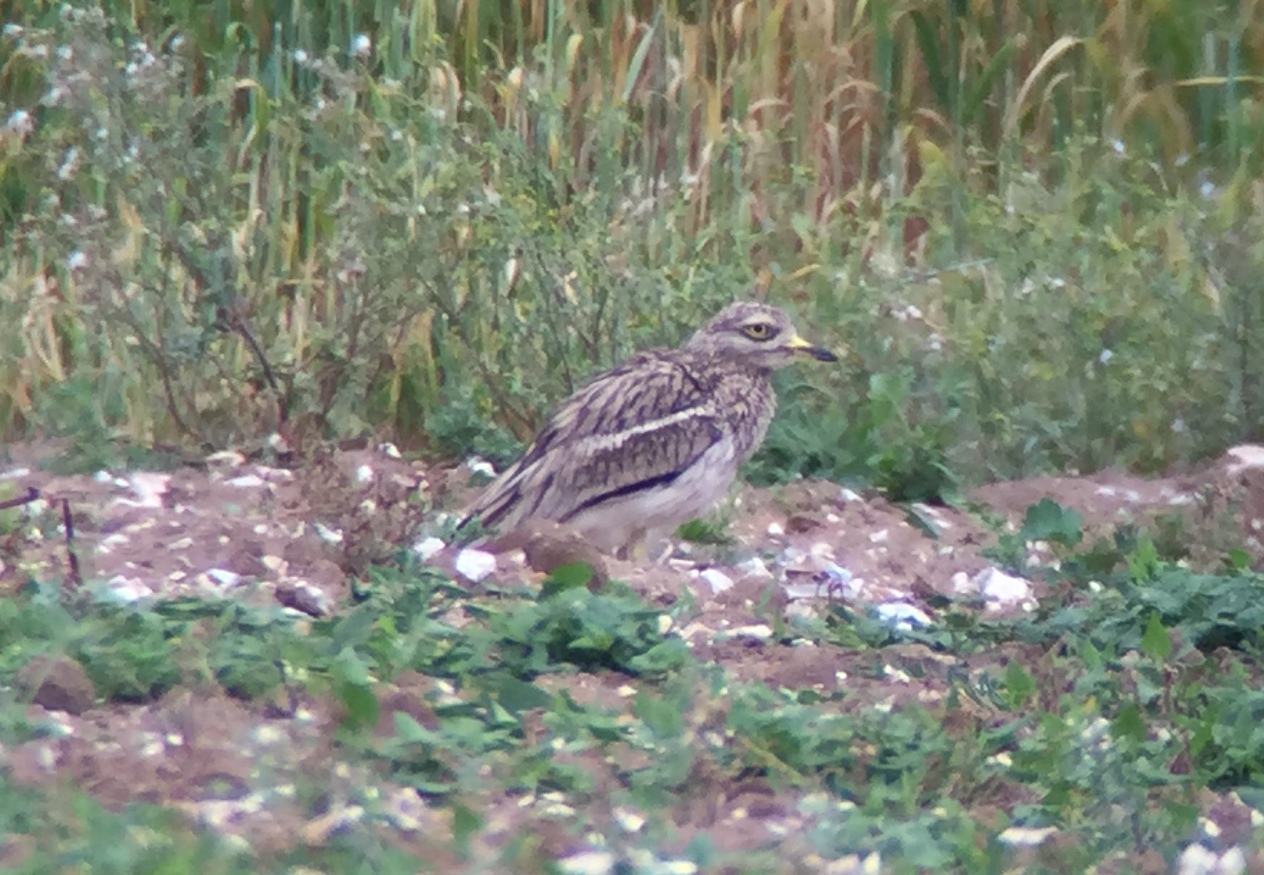
In the end, we had to tear ourselves away and left the Stone Curlew still standing out in the open in the field. With one of our main target species for the day already in the bag, we decided to head straight over to Lakenheath Fen next.
As we walked out onto the reserve at Lakenheath, we could hear a Cetti’s Warbler shouting from the bushes. There were lots of Reed Warblers feeding in the reeds and weedy vegetation by the path. There were lots of butterflies too – Red Admirals, Small Tortoiseshells and a smart Large Skipper.
 Large Skipper – on the walk out by the main path
Large Skipper – on the walk out by the main path
We stopped at New Fen Viewpoint for a scan across the reeds. There were just a few Coots on the pool today, adults and juveniles of varying ages. A Common Tern flew in and started hovering out over the water. A smart male Marsh Harrier flew across, and we saw a brief Hobby which was chasing a Magpie over the back of the reeds. A very distant pair of Kestrels circled over West Wood.
A Cuckoo was singing from the poplars as we walked out and, while we stood at the viewpoint, one came out of the trees behind us and flew out across over the reeds. It disappeared into the poplars along the other side. There were several Reed Warblers zipping about in the reeds around the water.
There is only one pair of Common Cranes breeding here this year and they are not in an accessible part of the reserve, so we had assumed we would not see any here today. We had been told by the warden in the visitor centre that six Cranes had been reported earlier, but as they had been flying around we were not sure if they had gone. At this point however they circled up over West Wood, and we watched as they circled across to the river and started drifting east.
 Common Crane – six flew over New Fen while we were there today
Common Crane – six flew over New Fen while we were there today
It looked like the Cranes would continue east over the river but when they got level with us they turned, and started coming straight towards us over edge of trees. They were not far away when they finally banked over the wood and started to circle up, before drifting back east. A real bonus!
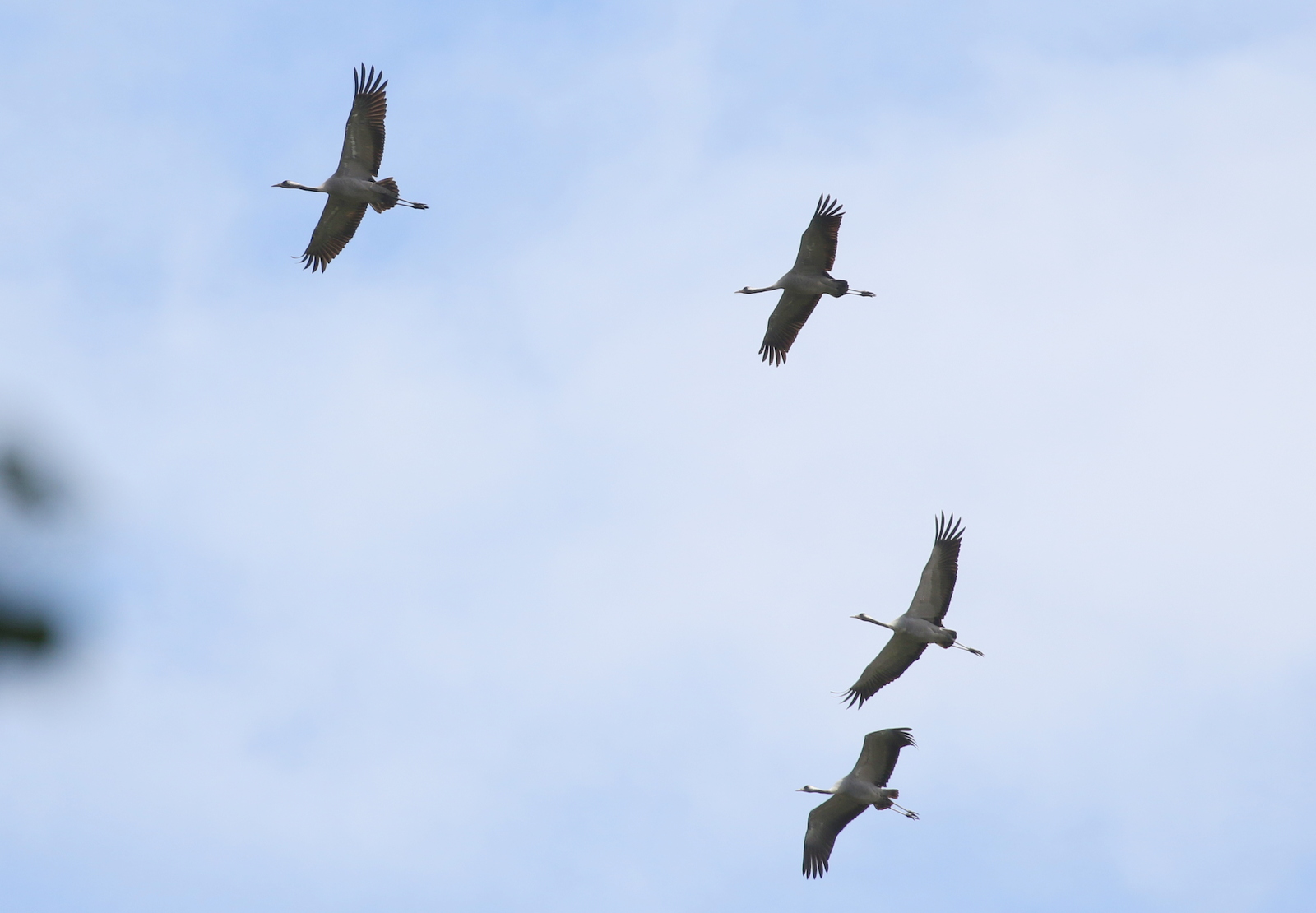 Common Crane – four of the six circling over East Wood
Common Crane – four of the six circling over East Wood
Continuing out along the main path, we stopped from time to time to look at the various dragonflies. These included good numbers of Black-tailed Skimmers and Ruddy Darters now, although still comparatively few mature red males of the latter species, plus a few Brown Hawkers and plenty of Four-Spotted Chasers still.
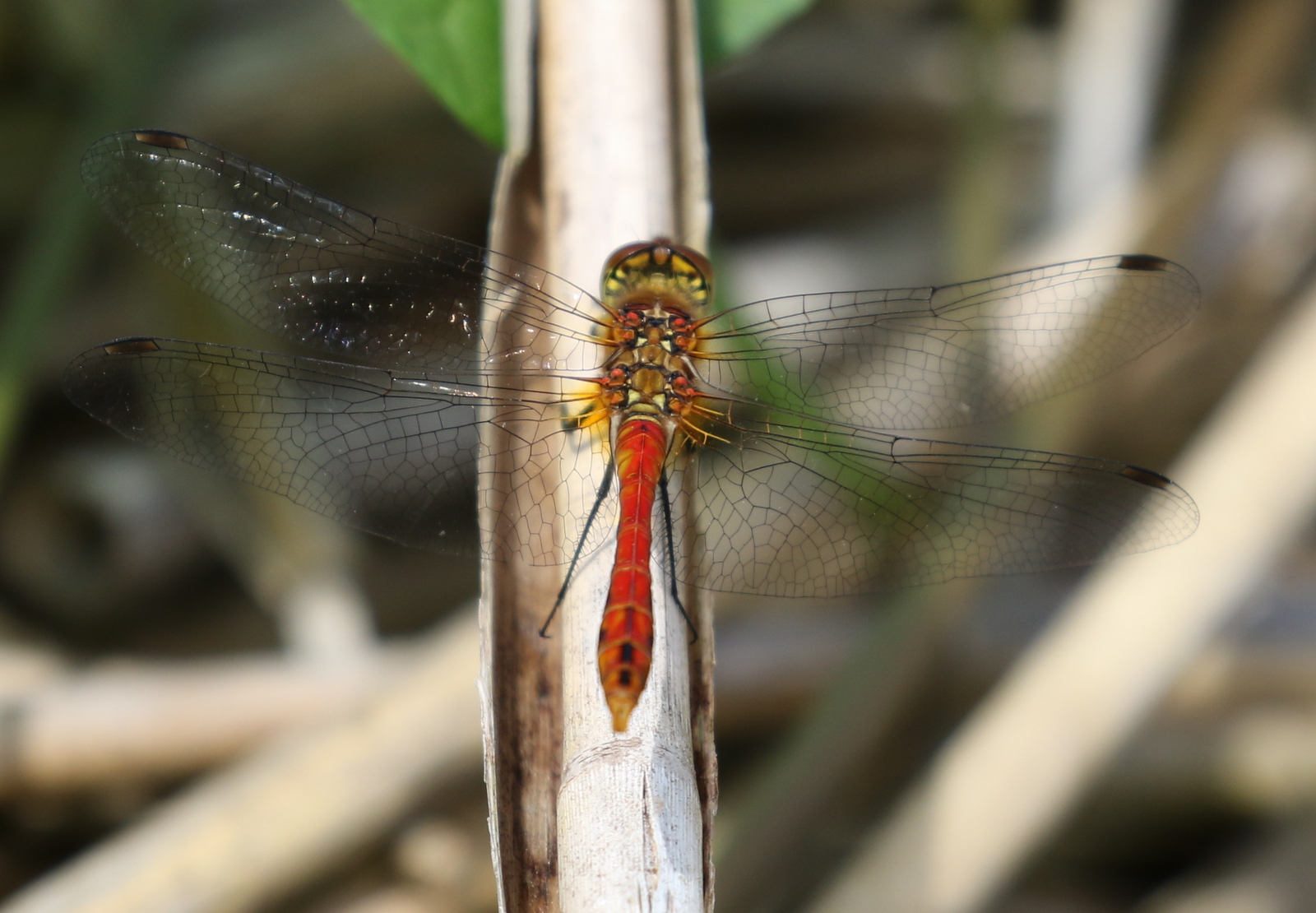 Ruddy Darter – a maturing male, gradually turning red
Ruddy Darter – a maturing male, gradually turning red
There was an excellent selection of blue damselflies here too – including several of the regular Common Blue, Azure and Blue-tailed Damselflies. The highlight was a single Variable Damselfly – a subtly marked one, with rather full blue antehumeral stripes.
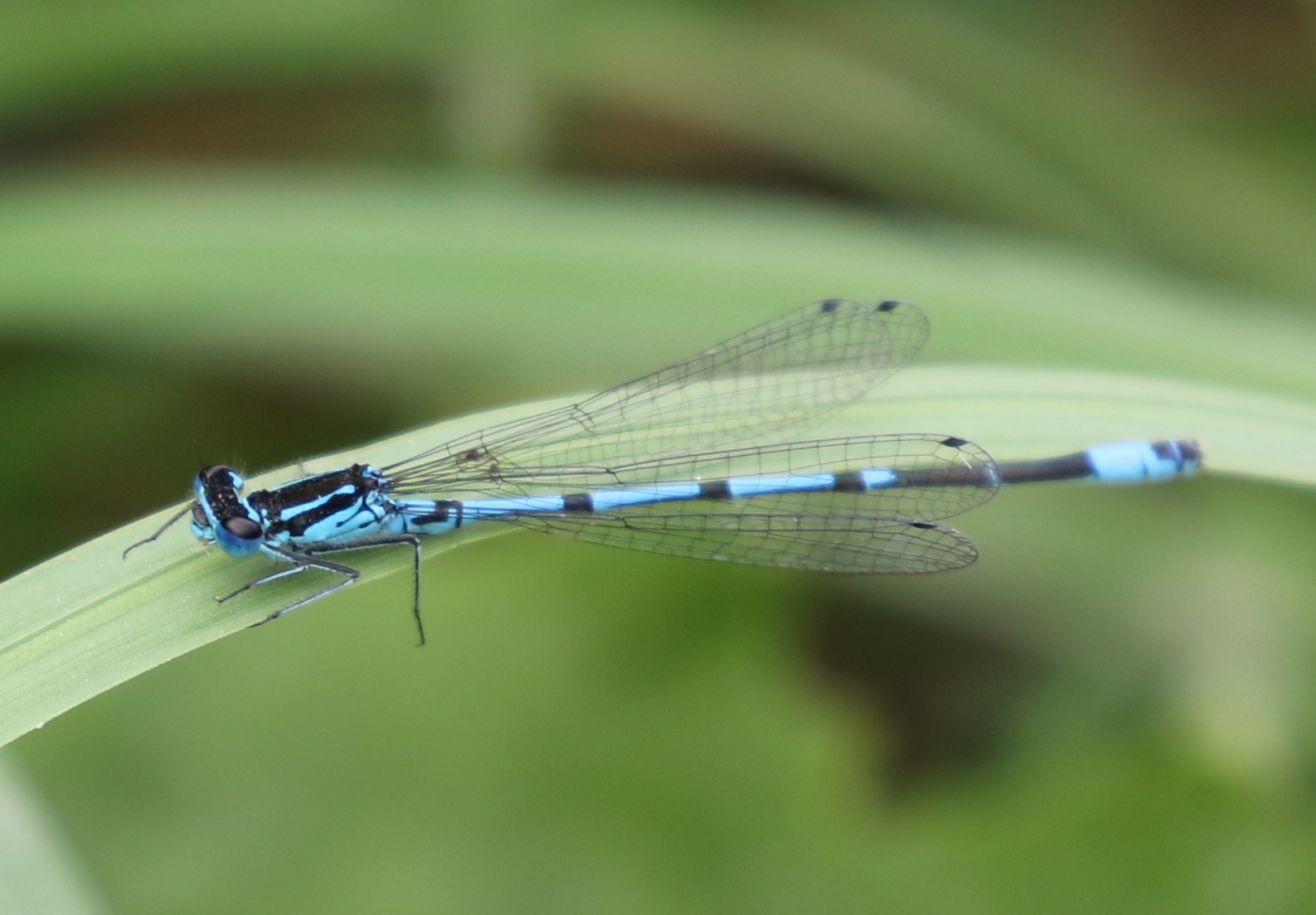 Variable Damselfly – with rather complete black antehumeral stripes
Variable Damselfly – with rather complete black antehumeral stripes
Another, this time avian, highlight was the Great Crested Grebe on one of the pools by path near West Wood. On closer inspection, we could see it was carrying two small, stripy juvenile grebes on its back. We could just see their black and white heads sticking out from their parent’s feathers. Why swim when you can ride in comfort!
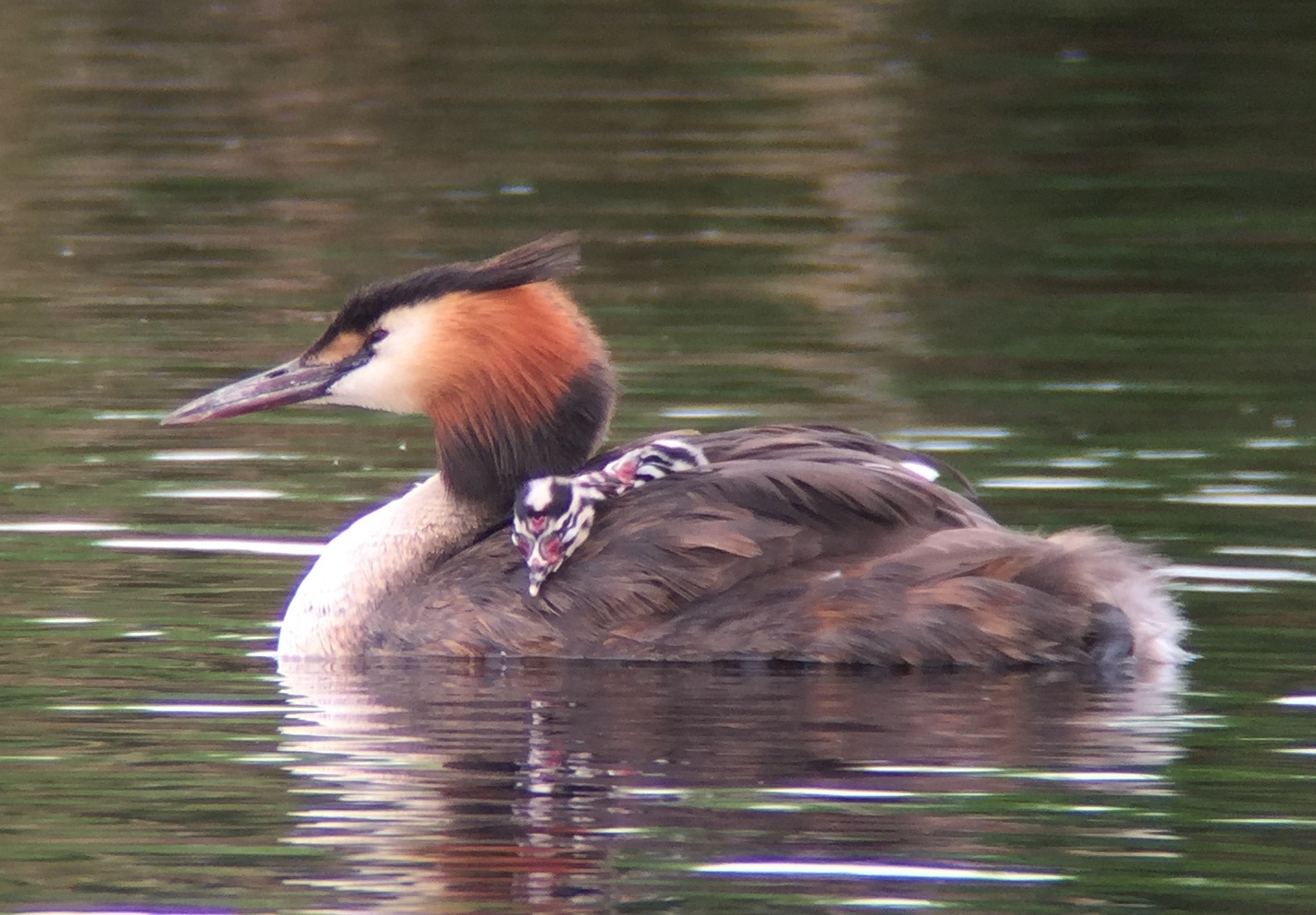 Great Crested Grebe – with two juveniles riding on its back
Great Crested Grebe – with two juveniles riding on its back
When we got out to Joist Fen Viewpoint, we sat down to rest after the walk out and had a look over the reeds in front. There were several Marsh Harriers circling out over the reedbed and lots of Reed Warblers around the pool in front. A Hobby shot across low over the reeds, giving us much better views than we had of the one earlier.
We had seen a pair of Bearded Tits in the edge of the reeds just as we approached the Joist Fen Viewpoint, but they had flown up and over the bank ahead of us. Sitting on the benches we found ourselves watching non-stop Bearded Tit action. Birds were zipping back and forth over the pool and feeding low around the base of the reeds on the edge of the water.
One pair of Bearded Tits, possibly the one we had seen flying over this way on the way out, was feeding some juveniles hidden down in the reeds right in front of us. The youngsters would occasionally perch up in the reeds begging when one of the adults returned. We had great views of them.
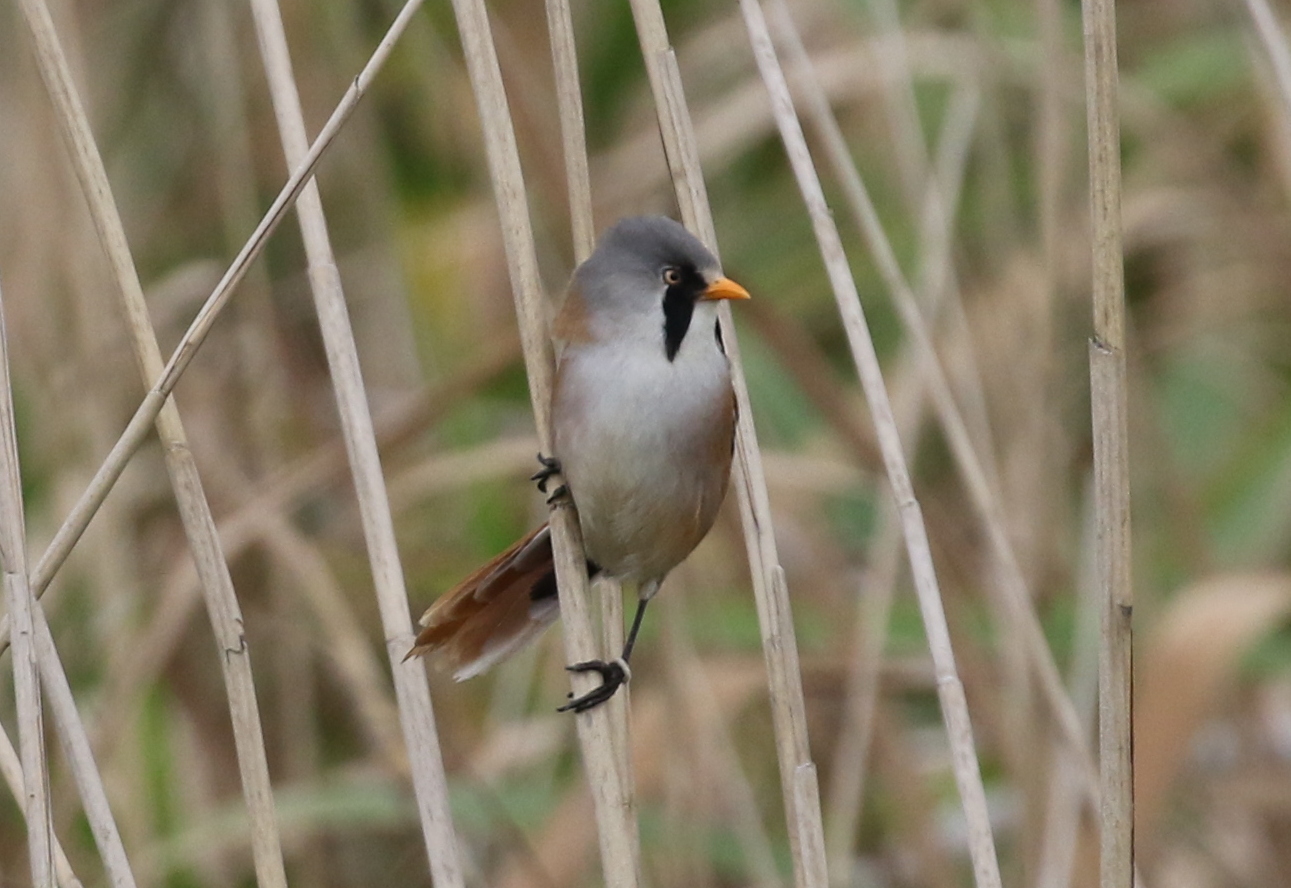 Bearded Tit – great views of adults feeding young in front of the viewpoint
Bearded Tit – great views of adults feeding young in front of the viewpoint
This is a great time of year to see Bitterns at Lakenheath Fen, with adults busy feeding growing young in the nest, and so flying back and forth from their favoured feeding areas regularly. But they kept us waiting today. We had one eye on the clock, aiming to get back for lunch, and time was ticking. There was just one tantalising glimpse, which was too quick for anyone to get onto. Eventually, we had nice views when a Bittern flew out of the bushes beside the viewpoint and away across the reeds in front of us, before dropping down into the vegetation. It was perhaps not the best view of Bittern we have had here, but it was good enough and would have to do as we needed to get back.
It seems Bitterns are like buses. Having had to wait to see the first at Joist Fen, we were walking back when one flew up from the reeds in front of us, right next to the path, flushed by someone walking along the path towards us. It was very close, and we had a fantastic look at it as it flew out across the pool, turning to fly past us before dropping back into the reeds. As if that wasn’t good enough, as we were walking past Mere Hide, another Bittern flew towards us low over the reeds beside the path, and carried on straight past us. Fantastic views!
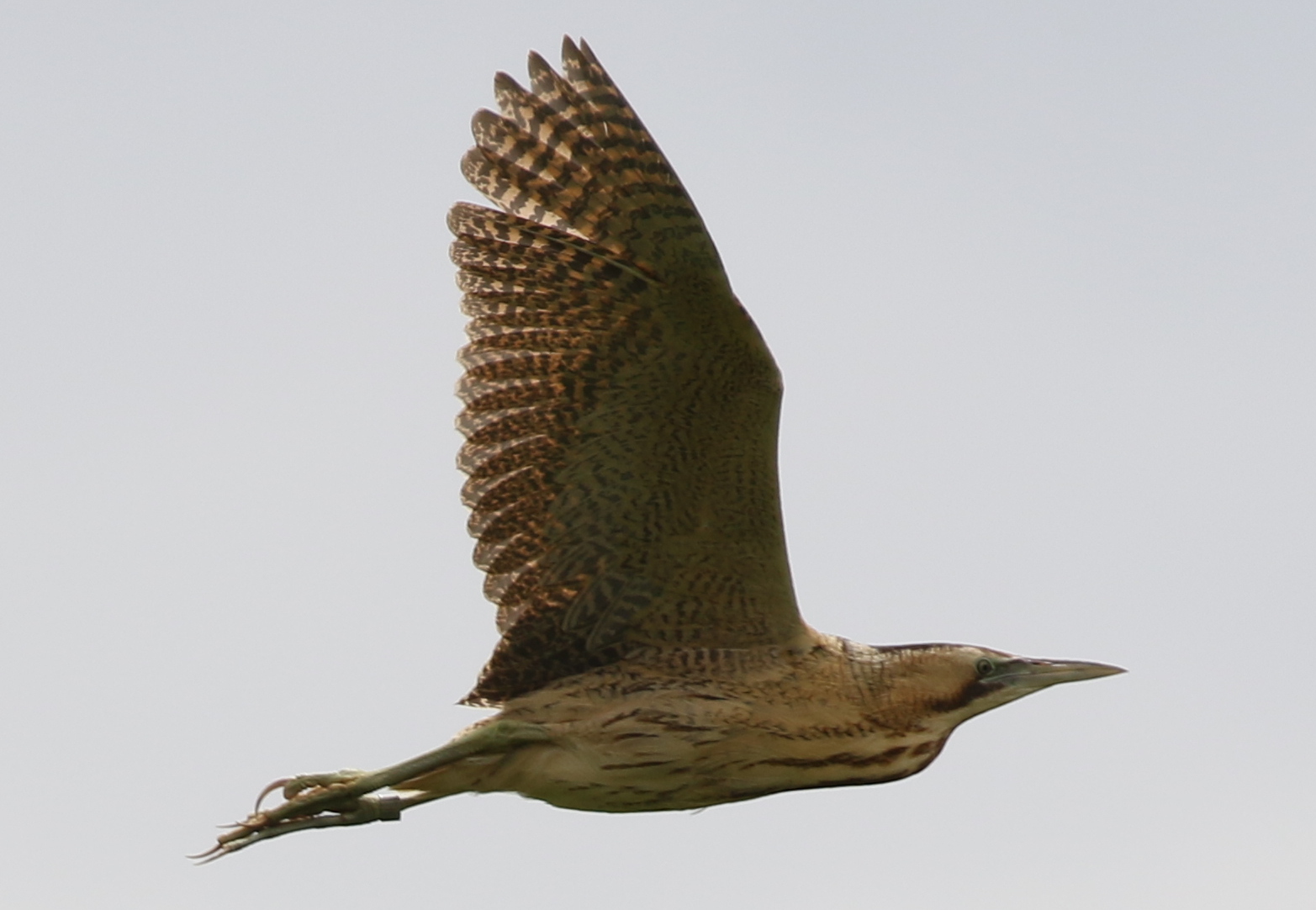 Bittern – we were treated to fantastic views of two on the walk back
Bittern – we were treated to fantastic views of two on the walk back
With a spring in our step, we walked back to the visitor centre, for a later than planned lunch outside at the picnic tables. After lunch, we had a quick look at the Washland. It is getting rather dry now, but still we managed to add a few waders to the day’s list – Lapwings, Oystercatchers, two Little Ringed Plovers, and a single Redshank. There were a few Mallard and Gadwall with ducklings, and a couple of Common Terns too.
We drove back to Thetford Forest for the rest of the afternoon, to try to catch up with some woodland birds. The little clump of trees where the male Redstart was singing a couple of weeks ago is now quiet. However, as we walked round into the clearing, we caught a glimpse of a Woodlark in the corner drop down into the grass. We walked round there to try to get a closer look.
As we made our way over, a Tree Pipit started singing. We watched as it fluttered up and then parachuted down across in front of us, landing again in the back of a large hawthorn bush. We could just see bits of it in the scope. Then, a second Tree Pipit flew over calling, and dropped into the top of another bush further back. This one was out in the open and facing us, so we got a much better look at it in the scope, although it was rather distant.
Carrying on around the clearing, we flushed a Woodlark from the long grass beside the path, possibly the one we had seen earlier. It flew round past us, showing off its short tail, and landed in a nearby pine tree briefly. We got a good look through binoculars, but it dropped down into the thicker branches before we could get it in the scope. A little further on along the path, we flushed another three Woodlarks from the grass, presumably a family party.
Continuing up to the far end of the clearing, we could hear a Tree Pipit singing again. We didn’t see where it came from, but we looked round to see it fly up into the edge of the pines and land on a branch. We got it in the scope and had a proper look at it, much closer this time. It had started spitting with rain as we walked round, and now it started to rain harder. It was still only light, but we made our way quickly back to the car just in case.
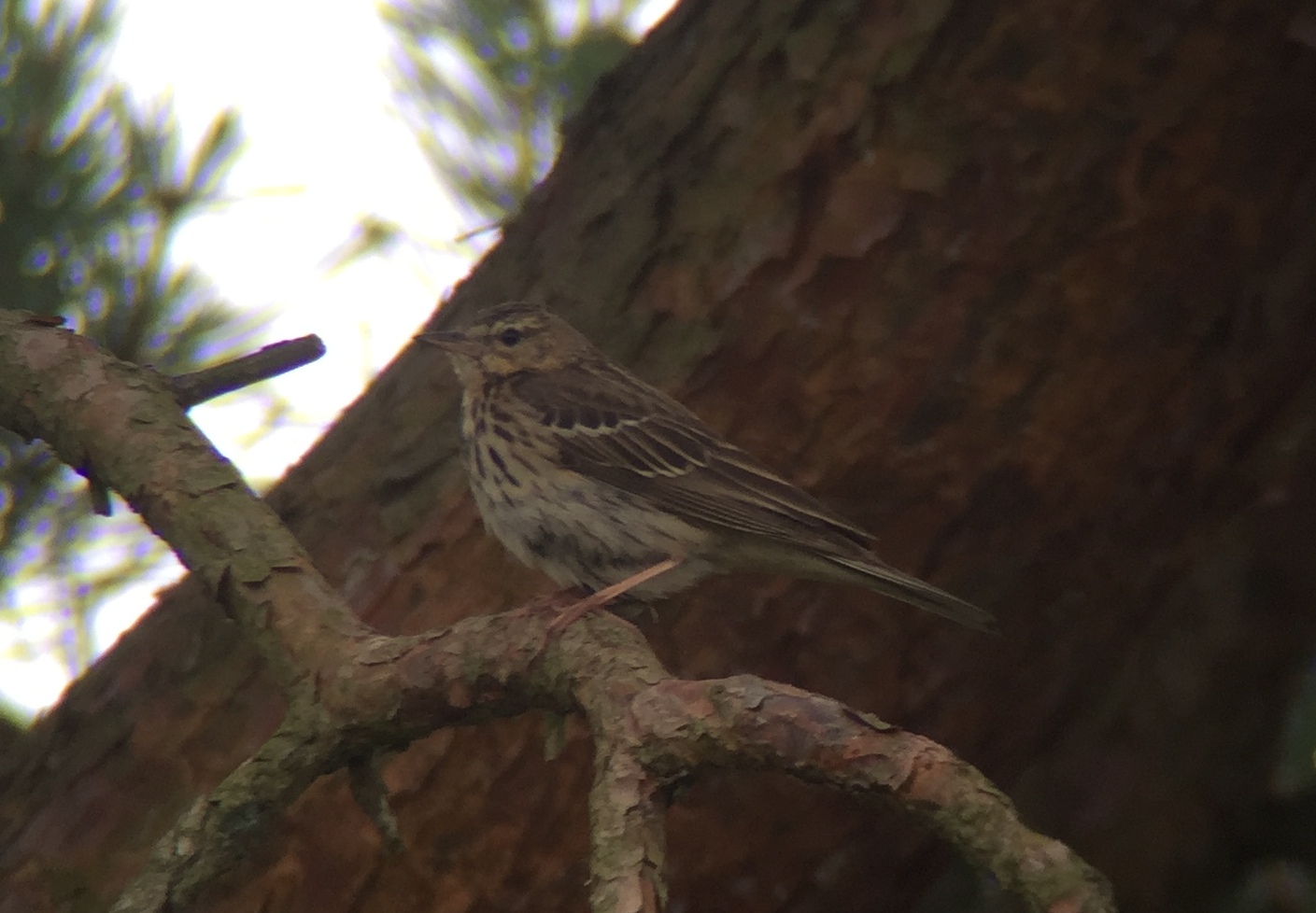 Tree Pipit – this one perched up nicely for us in the trees
Tree Pipit – this one perched up nicely for us in the trees
Thankfully the rain stopped almost immediately, as we drove round to Lynford Arboretum for the last hour of the day. We had already seen all our main target species, but we hoped we might be able to catch up with a few commoner woodland species here for our trip list.
As we walked across the road and into the Aboretum, we could hear a Grey Wagtail calling as it flew over the trees above our head, but we couldn’t see it. Several Goldcrests were singing from the fir trees. We stopped to watch a pair of Treecreepers, chasing each other around the trunk of a tree just before the gates to the new cottages. Suddenly a Spotted Flycatcher appeared in the same tree right next to them.
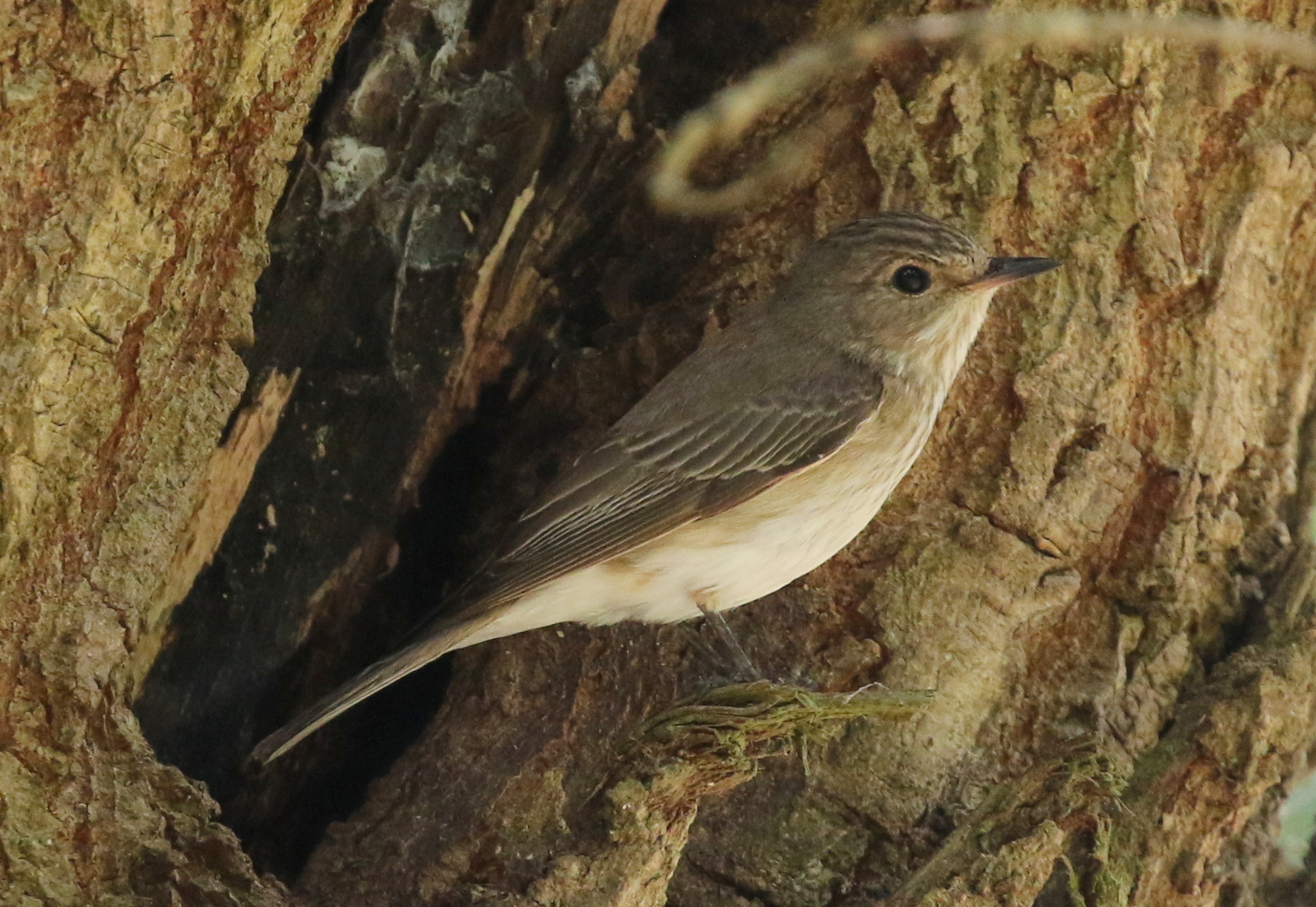 Spotted Flycatcher – showed really well as we walked in to the Arboretum
Spotted Flycatcher – showed really well as we walked in to the Arboretum
We got a great look at it, but the Spotted Flycatcher quickly flicked back over the other side of the garden wall behind. We walked up to the gates and could see it flitting around the roofs of the cottages. They are very subtle but very smart birds, and full of character. Spotted Flycatchers are getting much scarcer now, so it is always a pleasure to see one, especially as well as this.
Continuing on along the path, we stopped to admire the new wildflower meadow. It is looking really good this year, a riot of colour, and chock full of insects and butterflies. Several Emperor Dragonflies were hawking around over the vegetation. A female Kestrel was perched on a telegraph post in the field, and kept dropping down into the flowers, presumably after something tasty it had seen.
We had only gone a little further when we heard a bird calling from the trees across the field. It was a Hawfinch. We hurried along to a point from where we could scan over the trees and found it perched in the top of a fir tree. We all got a look at it through binoculars, but unfortunately it dropped down before we could get the scope onto it. We walked in along the path where it seemed to drop, but we couldn’t find it again. Hawfinches are regular here in the winter but are as rare as hens’ teeth here in the summer, and difficult to see when there are leaves on the trees too, so this was a real and most unexpected bonus!
Down over the bridge, we too the path along the side of the lake. There were a few tits in the trees and Swallows hawking for insects low over the paddocks. A Little Grebe was diving among the lily pads on the lake. As we turned to walk back, we spotted a juvenile Grey Wagtail lurking on the mud on the edge of the island.
It had been a very productive stop at Lynford and it made a really nice way to end the day and the weekend. We walked back up to the car – arriving just in time, as a heavy shower blew in. Our luck had certainly been in today!
















